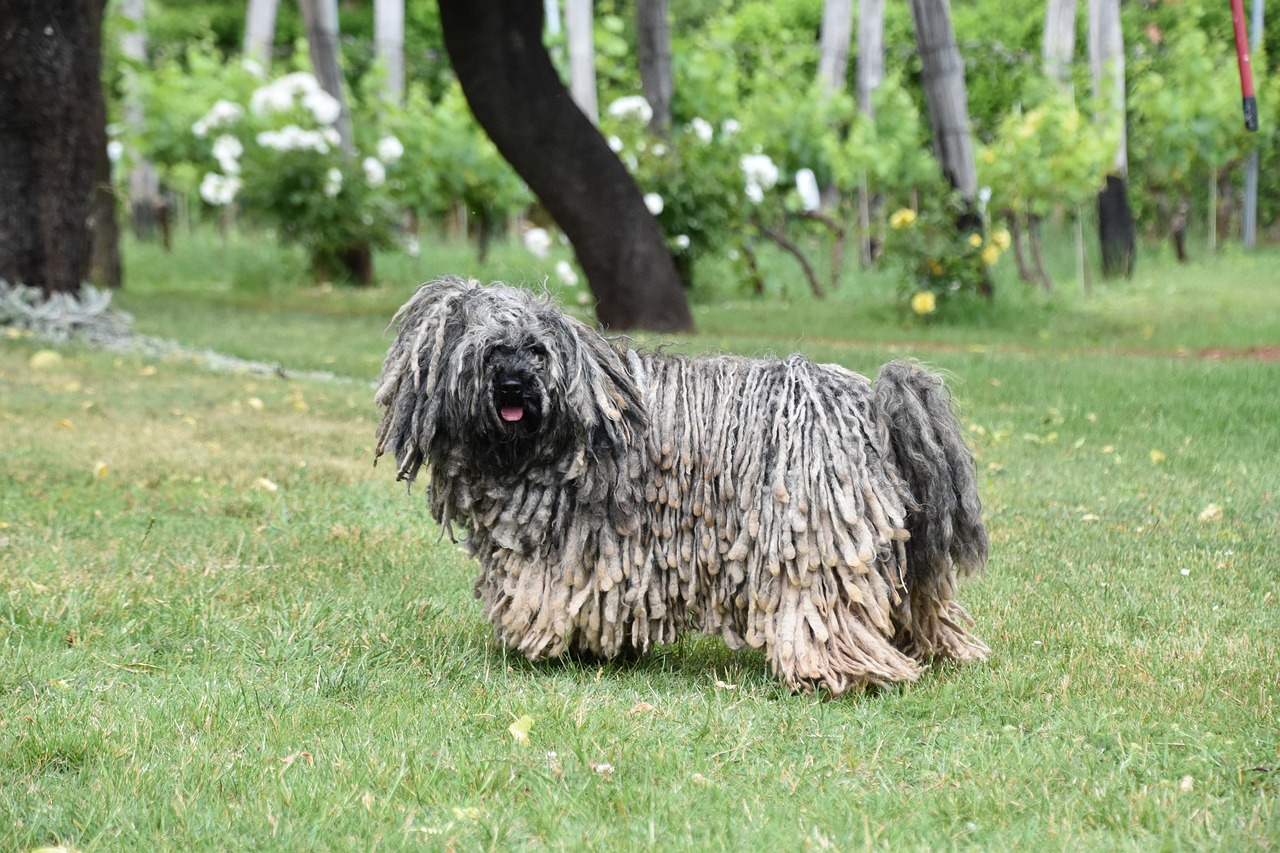Click and GO TO THE BEST DOG NAME GENERATOR HERE

The Puli dog breed, characterized by its distinctive corded coat, is often associated with its uniquely adaptable nature, particularly for apartment living. While their appearance may suggest a larger size, Puli dogs are actually compact and well-suited to apartment environments. When selecting a dog for apartment living, size alone should not be the primary consideration. Certain larger breeds, like the Puli, can thrive in apartments due to their low-energy and easygoing nature.
Other factors to consider include the dog’s quietness, sensitivity levels, ability to tolerate being alone, and adaptability to different weather conditions. This article aims to explore the various characteristics that make the Puli a suitable choice for apartment dwellers seeking a companion that is low-maintenance and well-suited to a confined living space. By understanding the factors that contribute to a dog’s adaptability, individuals can make informed decisions when choosing a breed that aligns with their apartment lifestyle.
Key Takeaways
- Puli dogs have a unique and distinctive appearance with their long, corded coat resembling dreadlocks.
- Some large dog breeds, including Puli, can adapt well to apartment living.
- When choosing a dog for an apartment, prioritize qualities like being quiet and low-energy.
- Dogs with low sensitivity levels and the ability to tolerate being alone are more suitable for apartment living.
Puli Appearance
The Puli breed is known for its unique appearance. It is characterized by a long, corded coat resembling dreadlocks, which gives them a distinctive and larger appearance than their actual size.
This distinctive coat is the breed’s most recognizable feature and showcases their mop-like appearance. The cords are formed by the hairs twisting and matting together, creating a dense and protective covering. The cords can range in length, with some Pulis having cords that reach the ground.
This coat serves a practical purpose, providing insulation and protection from harsh weather conditions. It also requires regular maintenance to prevent matting and keep the cords clean and healthy.
Despite their unique appearance, Pulis have a well-proportioned and muscular build. They have a compact body and a lively and alert expression. Their distinctive coat and overall appearance make them stand out among other dog breeds.
Adaptability Factors
When considering a dog for apartment living, it is important to take into account various factors that contribute to their adaptability. Size alone should not be the sole determinant, as some larger breeds can adapt well to apartment living while certain small dog breeds can thrive in apartments.
It is crucial to consider your neighbors’ comfort and prioritize qualities like being quiet and low-energy. Some small dogs may exhibit high energy and frequent barking, making them less suitable for apartment living in high-rise settings. It is essential to research breeds that are known to be quieter and lower-energy.
Additionally, novice owners should look for dogs that are easier to train and more easygoing, with training resources available for new dog parents. Dogs that tolerate being alone and are more independent are also desirable for apartment living.
Lastly, considering the climate in your area is important, as certain breeds may require jackets or sweaters for chilly walks.
Choosing the Right Dog
One important consideration in selecting a canine companion is finding a dog that aligns with your specific preferences and living circumstances. When choosing the right dog for apartment living, there are several factors to take into account. Here are three key considerations:
-
Size: While size alone should not be the sole determinant, certain small dog breeds can thrive in apartments. These breeds are known for their adaptability and ability to live comfortably in smaller spaces.
-
Temperament: It’s important to prioritize qualities like being quiet and low-energy when selecting a dog for an apartment. Some breeds are naturally more calm and relaxed, making them better suited for apartment living.
-
Neighbor comfort: Consider your neighbors’ comfort when choosing a dog for an apartment. Breeds that are known to be quieter and lower-energy are less likely to disturb neighbors with excessive barking or high energy levels.
By taking these factors into consideration, you can find a dog that will be well-suited to apartment living and will thrive in your specific living circumstances.
Breeds Unsuitable for Apartments
Breeds that exhibit high energy levels and frequent barking may not be well-suited for apartment living, especially in high-rise settings. These dogs, often small in size, can become restless and easily agitated in confined spaces, leading to excessive barking and disruptive behavior.
Additionally, their high energy levels require ample exercise and mental stimulation, which can be challenging to provide in an apartment environment. Breeds such as the Jack Russell Terrier, Beagle, and Dalmatian are known for their energetic nature and tendency to bark frequently, making them less suitable for apartment living.
It is important to consider the dog’s behavior and energy level when choosing a breed for apartment living, and research breeds that are known to be quieter and lower-energy to ensure a harmonious living environment for both the dog and its neighbors.
Novice Owner Friendly
Novice dog owners may benefit from selecting a dog breed that is easy to train and has a relaxed temperament. These breeds are often more forgiving of training mistakes and can bounce back quickly.
It is important for novice owners to consider their level of experience when choosing a dog. Some breeds are known for being easier to train and more easygoing, making them a good match for first-time owners.
Additionally, there are many training resources available for new dog parents to help them navigate the training process. By choosing a breed that matches their level of experience and utilizing these resources, novice owners can set themselves up for success in raising a well-behaved and happy dog.
Sensitivity Levels
Novice owners often prefer dogs that are easier to train and more easygoing. In this regard, sensitivity levels play a crucial role. Dogs vary in their sensitivity to reprimands, and it is essential to consider this factor when choosing a dog for apartment living.
Low-sensitivity dogs can handle a noisy household and are more tolerant of mistakes made during training. When considering your lifestyle and household dynamics, it is beneficial to research breeds that are known to be easygoing and resilient. These breeds are more likely to adapt well to apartment living and be forgiving of any training errors. Additionally, low-sensitivity dogs are generally more relaxed and less reactive, making them suitable for apartment environments where noise levels may fluctuate.
-
Sub-list 1: Factors to consider when choosing a low-sensitivity dog for apartment living:
-
Trainability and ease of handling
-
Ability to handle noise and distractions
-
Sub-list 2: Breeds known for their low-sensitivity levels:
-
Bulldog breeds (e.g., English Bulldog)
-
Retriever breeds (e.g., Labrador Retriever)
Tolerance of Being Alone
When considering a dog for apartment living, it is important to take into account their tolerance of being alone. Some breeds are more independent and can handle being left alone for longer periods of time without becoming anxious or destructive. These dogs are generally more self-reliant and do not rely heavily on constant human companionship.
It is crucial to consider your availability and work schedule when choosing a dog that can tolerate being alone. Researching breeds that are known to be more independent can help in making an informed decision.
By selecting a dog with a higher tolerance for being alone, apartment dwellers can ensure a harmonious living environment for both themselves and their furry companion.
Tolerance of Weather
Tolerance of weather is another important factor to consider when choosing a dog for apartment living. Different breeds have varying levels of tolerance to both cold and hot weather conditions.
Breeds with short coats or little body fat are more vulnerable to the cold, requiring them to live inside in cool climates. On the other hand, breeds with thick, double coats may struggle to cool themselves off and are more susceptible to overheating in hot weather.
It is crucial to consider the climate in your area and select a breed that can comfortably handle the temperatures. Additionally, certain breeds may require jackets or sweaters for chilly walks, while heat-sensitive breeds need to stay indoors on warm days.
Researching breeds known for their tolerance of specific weather conditions can help ensure the well-being of your apartment dog.
Frequently Asked Questions
How much exercise does a Puli need?
The exercise needs of a Puli dog can vary depending on factors such as age, health, and individual temperament. Generally, Pulis are an active breed and require a moderate amount of exercise to maintain their physical and mental well-being.
Daily walks, playtime, and engaging activities are recommended to keep them stimulated. It is important to consult with a veterinarian or professional dog trainer to determine the specific exercise requirements for a Puli based on their unique needs.
Are Pulis good with children?
Pulis are generally good with children. They are known to be affectionate and loyal, which can make them great companions for kids. However, their adaptability to apartment living does not directly correlate with their compatibility with children.
It is important to supervise interactions between pulis and children to ensure the safety of both parties. Despite their generally good nature, any dog can become overwhelmed or stressed in certain situations, so it’s important to be cautious.
Early socialization and training are crucial for pulis to learn proper behavior around children. Teaching them how to interact gently and calmly with kids will help prevent any accidental injuries or rough play.
In conclusion, while pulis can be great with children, it is important to remember that individual dogs may have different temperaments. Supervision, socialization, and training are key to ensuring a positive and safe relationship between pulis and children.
Do Pulis shed a lot?
Pulis are known for their unique corded coat, but shedding is not a significant issue with this breed.
Their coat is non-shedding, which means they do not lose a lot of hair like other breeds.
Instead, the Puli’s coat naturally forms cords that prevent loose hair from falling out.
While they require regular grooming to maintain their distinctive appearance, the Puli’s coat does not shed excessively, making them a suitable choice for individuals who are concerned about pet hair in their homes.
Are Pulis easy to train?
Pulis are generally considered to be moderately easy to train. They are intelligent and eager to please, which can facilitate the training process. However, their independent nature may sometimes lead to stubbornness and a need for consistent and patient training methods.
Positive reinforcement techniques, such as rewards and praise, tend to work best with this breed. It is important to start training early and socialize them well to ensure they become well-rounded and obedient dogs.
How often does a Puli need grooming?
The grooming needs of a Puli can vary depending on the individual dog and its lifestyle. However, due to their unique corded coat, Pulis require regular and thorough grooming to prevent matting and maintain the health of their coat.
It is recommended to brush their coat at least once a week to remove any debris and tangles. Additionally, regular bathing and trimming may be necessary to keep their coat clean and manageable.


